-
Arnaud Desplechin: JIMMY P., PSYCHOTHERAPY OF A PLAINS INDIAN (2013
ARNAUD DESPLECHIN: JIMMY P., PSYCHOTHERAPY OF A PLAINS INDIAN (2013)
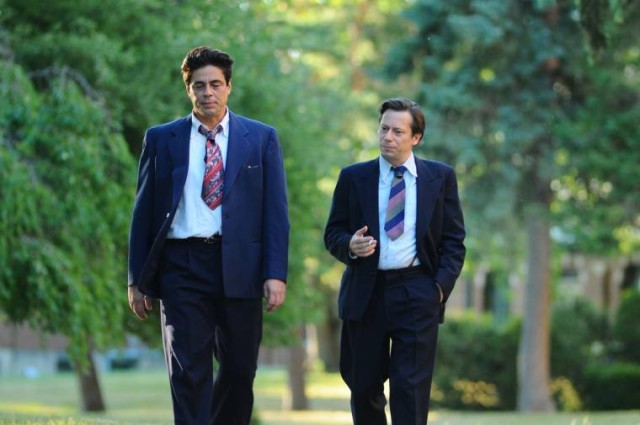
Benicio del Goro and Matthieu Amalric in Jimmy P.
Just what the title says
Arnaud Desplechin's Jimmy P., Psychotherapy of a Plains Indian (2013) seems a dubious enterprise. How can you base a movie on a shrink-patient relationship not involving a mafioso, Gandolfini, or De Niro? Mark Adams of Screen Daily thinks you can. He calls Desplechin's new film "An impressively nuanced and intriguingly un-showy drama," and " a film of subtle understatement." It resists, he says the "temptation to engage in overly dramatic flourishes" and provides "a solid platform for the charismatic talents of Benicio Del Toro and Mathieu Amalric, who deliver memorably mannered performances." Moreover this film has been well received in France, this auteur's home ground, where it got an Allociné press rating of 3.5.
Wait a minute, though. Do you want to watch almost two hours of two actors wearing wide Forties ties in Topeka delivering "memorably mannered performances" while they talk about a Native American's prewar hangups? Aren't those adjectives about being "un-showy" and "of subtle understatement" just cover words for dull? This is how Jimmy P. came across to me: dull, and inexplicable. Much has been made of Amalric's and Del Toro's "different acting styles," but mannered is mannered: they just both seem false. Amalric ain't a Hungarian Jew and Del Toro ain't a Plains Indian. They're a Frenchman (though of Hungarian Jewish ancestry) and a Puerto Rican. And Desplechin stakes his all on his two main actors, a big risk. He surely knew what he was getting with Amalric, who's in so many of his films, and is the analysand rather than the analyst in an early work, My Sex Life... (1996). Del Toro may have been largely on his own, and pretty lost.
Something may also have gotten lost in translation with the scenario. The film comes from a well-known book. Georges Devereux’s 1951 Reality And Dream, which is an exhaustive account of the French-Hungarian-Jewish anthropologist-therapist-Indian specialist's treatment of the Blackfoot vet Jimmy Picard. Picard came to Karl Menninger's Winter General Army Hospital in Topeka, Kansas, which was to become a great training ground for psychiatrists. He suffered from crippling symptoms, including terrible headaches, temporary blindness, hearing loss, jittery arm, and dizzy spells, but the specialists found nothing organically wrong and therefore at first concluded he was schizophrenic.
Devereux was called in from New York (to his delight; he had nothing to do and welcomed the project) even though he was not technically a doctor. His approach to Jimmy's problems was whollistic, and apparently successful: his patient's symptoms went away. Devereux had lived two years with the Navajo and learned their language and in discussing Jimmy's past he made constant, reassuring use of a knowledge of tribal structure, including male-female roles. Jimmy turned out to have various female issues all his life, starting with finding his mother in bed with a man not his father. He would not marry the mother of his daughter, and felt guilt over this. It's suggested by Mark Adams and the film itself that both men got therapy out of their hour a day together. What are we to make of the long visit by his Devereux's married lover Madeleine (Gina McKee)? It's inconclusive, tacked-on, and incomprehensible, as if there were some meaningful scenes that got left on the cutting room floor.
The mildly interesting but still rather plodding account of Jimmy's psychiatric voyage of healing self rediscovery (which includes occasional flashback restagings) lacks the kind of flashy drama we get, for instance, in Jung and Freud's pioneering treatment of the "hysterical" (and quite deranged) Sabina Spielrein, as depicted in David Cronenberg's A Dangerous Method, or Charcot's treatment of an illiterate housemaid as shown in Alice Wincour's Augustine -- not that I'd recommend either of these films as depictions of psychotherapy. But is psychotherapy a good subject for a film? Some processes have to be elided or kept in the background, or, as in those two films, sensationalized, for them to come to life on screen.
Jimmy P. seems largely a misfire, a false step, for Desplechin, a bold experiment that grew out of his passion for the subject of psychotherapy and a temptation to dip his toes into American waters. Perhaps because he was in untried territory, he trods a timid, pedestrian path, slavishly following a book that's itself just a day to day record. It was in French, and translated into English by Kent Jones of the New York Film Society, where he's Associate Director of Programming of the Walter Reade Theater and Editor at Large of the society's organ Film Comment magazine. Which is to say this film is an offshoot of the New York Film Society itself, a case where the jurors of the Main Slate decided to order in. This reminds one of another NYFF vanity project that Benicio Del Toro was centrally involved in, Steven Soderbergh's Che. But while Soderbergh worked on a scale larger than he'd ever attempted before in that film, in this one Despechin narrows down his usual polyphonic approach, and the effect is a little bit claustrophobic.
Still Jimmy P. is arguably a more worthy film to be included in the NYFF than a comedy by Roger Mitchell or Richard Curtis. It seeks to be an original and experimental work. Desplechin is a worthy NYFF alumnus; his earlier films showed brilliance; this one has seriousness of purpose. However, Mike D'Angelo's Cannes tweet review gave it a 35 and said, "35. I was not expecting to leave this film thinking fondly of GOOD WILL HUNTING." In other words, the material winds up being thoroughly middlebrow, but flatter than Van Sant, and certainly than Cronenberg.
Jimmy P., Psychotherapy of a Plains Indian/Jimmy P. psychothérapie d'un indien des plaines, 117 mins., debuted at Cannes. Screened for this review as part of the New York Film Festival at Lincoln Center.
Last edited by Chris Knipp; 01-02-2015 at 06:42 PM.
-
Corneliu Porumboiu: WHEN EVENING FALLS ON BUCHAREST OR METABOLISM (2013)
CORNELIU PORUMBOIU: WHEN EVENING FALLS ON BUCHAREST OR METABOLISM (2013)

Alexandru Papadopol and Diana Avramut in When Evening Falls on Bucharest or Metabolism
A filmmaker looks at himself, in 11-minute segments
Corneliu Porumboiu, the Romanian director of Police, Adjective (NYFF 2009), takes aim at more sophisticated, universal material with this sustained foray into the self-referential, post-modern cinema of exhausted ideas. When Evening Falls on Bucharest or Metabolism is a formalized, ironic look at the filmmaking process centered around a worldly, egocentric, neurotic, urban director apparently as interested in seducing actresses as in making good films. But he may make quite good films. That's just not what we get to see him doing.
This instead is a series of clearly defined one-reel film segments that dryly look at a working movie director during off hours. He flirts with, plays with, dines with, discusses with, off-screen has sex with, his actress and talks about the screenplay and his stomach problems. The film ends with a look at an endoscopy, ostensibly the director's. A metaphor, perhaps, for what he has been doing here, though the interior or personal world of the director examined is of a very abstracted, formalized, trivialized sort.
The film opens in a car, dark outside. Two people talking, the director and a woman. He explains to her differences between digital and film. He says he is used to organizing his work into the eleven minutes of a single reel of film and therefore can't shoot in digital format, because it runs longer, and he'd lose the run-time shooting structure he's familiar with working in. So then each successive segment of the film we are watching, shot on film, is so organized, into a total of eight segments, eight reels, eighty-nine minutes. The result for the viewer is a sense of a formal task duly executed. Porumboiu defines the limits of the medium as he practices in it and, perhaps, in so doing transcends them.
Thus the Romanians, who dealt with failed revolution, police corruption, petty crime, illegal abortions, adultery and criminal families, move on, in Porumboiu's case, anyway, with When Evening Falls on Bucharest or Metabolism to elegant conceptual navel-gazing. But we should note that this isn't a wholly new direction for Porumboiu. Even in Police, Adjective he wound up with an aria about the tyranny and triumph of language. But this time we are treated to a consideration of whether and how chopsticks have altered the nature of Chinese cuisine, versus knife and fork for the Europeans, and eating with their hands, for the "Arabs" [sic].
But this time Porumboiu's effort may be taken as priggisly tidy, as accomplished at the cost of lifelessness. As Jay Weissberg says in his Variety reiiew, "Corneliu Porumboiu's latest drama is so carefully intellectualized that the picture has no room to breathe." it's ironic that he introduces references to Monica Vitti and Antonioni, neither of whom, depressingly enough, his young actress has even heard of. If L'Avventura is Porumboiu's model, he has fallen fall short of it. The "sick soul of Europe" has been reduced to Euclidian geometry. Corumboiu has mentioned Hong Sang-soo, but the Korean film directors bumbling around in search of women and getting drunk in bars, are good old boys compared to this self-conscious fellow, who never quite seems to enter even a cinematic "real world."
When Evening Falls on Bucharest or Metabolism/Când se lasa seara peste Bucuresti sau metabolism, 89 mins., debuted at Locarno, and was screened for this review as part of the Main Slate of the New York Film Festival at Lincoln Center, September 2013.
Last edited by Chris Knipp; 01-02-2015 at 06:44 PM.
-
Plippe Garrel: JEALOUSY (3023)
PHILIPPE GARREL: JEALOUSY (2013)
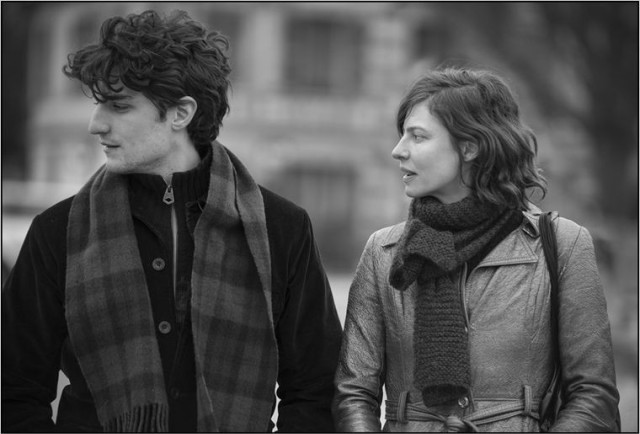
LOUIS GARREL AND ANNA MOUGLALIS IN JEALOUSY
Leaving the mother and wooing the child
Garrel is on (literally) familiar, almost inbred, territory in Jealousy, a handsome new black and white 'scope film featuring his son Louis in a role based on his grandfather, Philippe's father, the actor Maurice Garrel, who died in 2011 and dealt at this age (Louis is now 30) with two girlfriends and a child by the one he has left. There were questions about Philippe's previous film, Un été brülant ("A Burning Hot Summer"), whose color when I saw it in a little Paris cinema looked bad (I hope a projection problem), and action desultory, the performance of Monica Bellucci and her casting as Louis' wife dubious. Jealousy isn't a stretch for Philippe -- it's the same kind of film he has made before; but it moves with an easy, sprightly rhythm, and Louis' improvisatory skills are shown to fine, yet unobtrusive, advantage, particularly in scenes with the feisty and irrepressible Olga Milshtein as his little daughter. Louis' sister Esther Garrel plays the film Louis' sister.
Still possessing his pale, poetic good looks and irrepressible mop of black hair, Louis Garrel has had a good decade since he first came to the attention of the international audience in 2003 (at 20, obviously) with Bertolucci's The Dreamers. He has played muse for two filmmakers, his father, who's used him four times, and Christophe Honoré, who seems madly in love with him and has wanted to use him in every film he's made since their first outing (with Isabelle Huppert) in the dicey oedipal story, Ma Mère, six times so far. His roles with Honoré have been more varied, those with his father, more iconic.
The latest Louis is an impoverished actor. He leaves Clotilde (Rebecca Convenant) at the outset, devastating her. But as the first section title says, "Je gardais les anges" (I kept the angels), which apart from a personal anecdotal meaning refers to Louis's maintaining regular (and charming) contact with little Charlotte (Milshtein). He lives in a garret with his new "femme," Claudia (Anna Lougalis), once a coming actress, now unable to find work for years. Louis tries to help Claudia get a role, in vain. Clauda becomes despondent; she hates the garret. In the director's words, "The woman cheats on him. And then she leaves him. The main tries to kill himself, but fails. His sister visits him in hospital. She's all he has left -- his sister and the theatre."
Charlotte is Philippe Garrel as he was as a child. She meets Claudia, and in admiring her, she makes her mother, Clotilde, jealous, as he once did.
The flow of scenes is rather like Philippe's personally autobiographical I No Longer Hear the Guitar (FCS 2008), with the same classical simplicity, softened by Louis' ease on screen and chemistry with the "ladies," including the little girl, arguably more technically accomplished, despite simple means. One thing that's different this time is the involvement of Caroline Deruas, Arlette Langmann, Marc Cholodenko, and Philippe Garrel in the writing of the scenes, with different people, occasionally more then one, writing a random sequence of scenes, and Philippe using what worked best, making this in the words of Leslie Felpein of Variety more "tightly scripted" than usual, also, due largely to the lightly sentimental, slightly comic father-daughter scenes, possessed of an "unexpected emotional warmth" (she adds). Philippe is well served by the hand-held Scope camera work of Jean-Paul Meurisse and Willy Kurant as d.p. Music is sparingly used as a brief connective between big segments. Editing by previous associate Yann Dedet (who worked with Truffaut and Pialat), also adds to the good work here.
It is hard to imagine my liking any Philippe Garrel film better than his deeply atmosphere meandering epic of 1968, Regular Lovers (NYFF 2005), (which makes Bertolucci's look like an empty, if pretty, bauble), but Jealousy is among the Garrel films one could enjoy coming back to. And it's blessedly short. Yes, every Louis Garrel role in a film by his father has involved a young man attempting suicide, sometimes successfully -- all part of the doomy poetic mood, lightened a bit this time. (For a beautiful but gloomier and less emotionally engaging outing of the two Garrels, see The Frontier of Dawn (FCS 2009), reviewed here at another earlier Lincoln Center series.
La jalousie, 76 mins., debuted at Venice and was screened for this review as part of the New York Film Festival at Lincoln Center, Sept.-Oct. 2013. It will open in Paris 4 Dec.
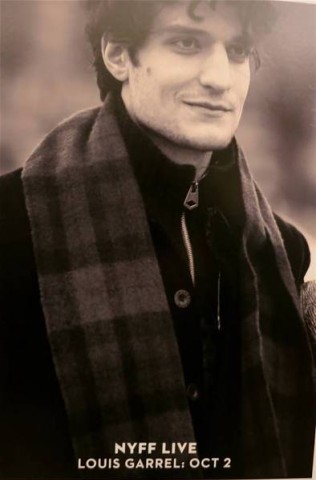
Backlit NYFF street advert on Broadway [CK photo]
Last edited by Chris Knipp; 01-02-2015 at 06:49 PM.
-
Tsai Ming-liang: STRAY DOGS (2013)
TSAI MING-LIANG: STRAY DOGS (2013)
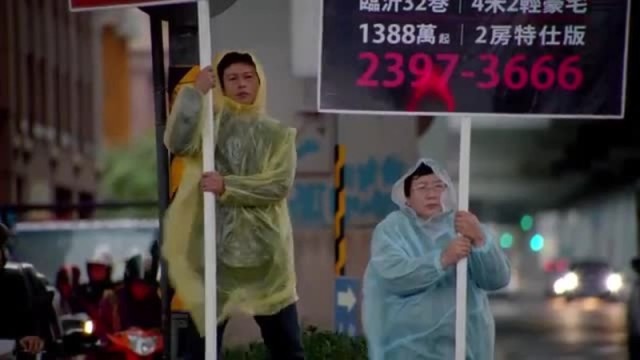
It's a dog's life
Stray Dogs is a punishing, slow-moving, non-narrative depiction of the lives, such as they are, of a family, such as it is, of very marginal people living on the fringes of Taipei society. As Variety critic Guy Lodge put it when he saw the film at Venice, this film "will be adored by his hardcore devotees and precisely no one else."
There are long takes, sometimes up to ten minutes. In one, a woman holding a shopping bag and a flashlight stands staring at a mural in an abandoned building, a landscape with rocks, for many minutes. Then she squats, relieves herself, and moves off, stage right.
Stray Dogs shows a man who works as a billboard carrier in busy intersections, often in heavy rain. He spends the meager earnings from this on food, drinks, and smokes. His two kids seem to survive during the daytime by eating food samples given out at large supermarkets. He takes care of them at night, when they sleep in a space in a warehouse, or something. Early on a woman has been seen combing her hair, while two kids slept. Commentators believe two other actresses may be used as stand-ins for this same woman, who may be the mother. The woman feeds some dogs, hence the double meaning of the title.
Much attention is given to eating, sleeping, and attending to the bodily functions. There is very little dialogue. Toward the end there is a reunion and a moment of affection. Settings are urban, industrial, and impersonal.
Tsai has always been odd and avoided narrative, but he began as a whimsical filmmaker with references to the French Nouvelle Vague (What Time Is It Now?), and had a feisty young alter ego in his films. He has said in recent interviews that he is tired of making movies. Maybe he wants to make us as tired of watching them -- at least his.
However, devotees of the non-narrative who also perhaps take this film as useful social commentary will see it quite differently. I quoted Guy Lodge, whose reaction is similar to mine. However the Telegrah's critic writes, "Every shot of Stray Dogs has been built with utter formal mastery; every sequence exerts an almost telepathic grip." The Playlist's critic enthuses that "The filmmaking here is almost impossibly well-realized, right down to the evocative sound design, adding up to an fairly unforgettable experience." Other sites have admiring dialogues about this film that assume its importance and artistic mastery. Hollywood Reporter notes, "Winner of the Grand Jury Prize in Venice, this despair-drenched portrait of a stray family on the disenfranchised fringes of Taipei society may be his sparest work yet, speaking to devotees but unlikely to lure many fresh converts. "
Stray Dogs/Jiao you, 138 mins., debuted at Toronto and Venice. Screened for this review as part of the New York Film Festival at Lincoln Center, Sept. 2013.
Last edited by Chris Knipp; 01-02-2015 at 06:51 PM.
-
Jehane Noujaim: THE SQUARE (2013)
JEHANE NOUJAIM: THE SQUARE (2013)
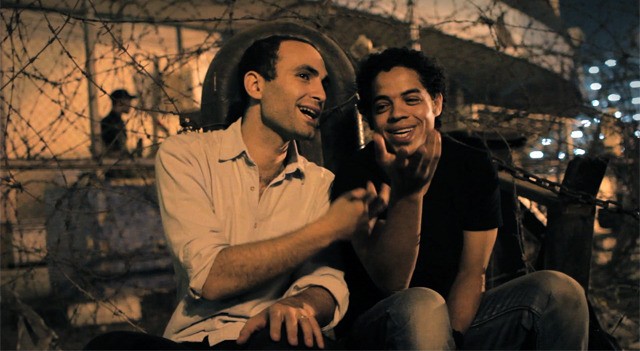
Khaled Abdallah and Ahmed Hassan in The Square
[b]The youth revolution of 25 January 2011 when hope was still high[/b]
Noujaiim's documentary, The Square, referring to Meidan at-Tahrir ("Liberation Square") in Cairo, is an astonishingly warm and emotional film even considering the intensity and significance of the tumultuous events it chronicles. This is due to some dedicated work by a handful of photographers, including the director, and their choice to highlight the experiences of a small set of people they met in Tahrir, some of whom became friends across political and social lines in the surge of democratic, revolutionary feeling that swept through Egypt after January 2011.
These people are unfailingly moving and articulate, even, and most notably, Ahmed Hassan, a young man who was virtually a child of the streets selling lemonade, who hails from a poor family living in the bast, popular Cairo district of Shubra. Inspired by the love of freedom, democracy, and revollution the removal of the dictator Hosni Mubarak awakens in him, Ahmad becomes a charismatic leader in the Square. What you won't entirely find here are what following the chosen personalities takes space from. This includes a full account of all the events in the Square itself over the two-year period roughly covered, a blow-by-blow history of all the political manoeuvring that take place on all sides, or an analysis of the deep government of the military headed by the SCAF (Supreme Council of the Armed Forces) that remains more in control than ever since the ouster of Muhammad Morsi, Mubarak's elected successor as Egypt's president.
Ahmed Hassan -- ordinary name -- is the star of this film, and reportedly he has been drafted into the Egyptian army. In a Q&A after a screening of the film for press and industry in connection with the New York Film Festival, September 2013, Noujaim said that the next film would be Ahmed in the army. If this is true it would be remarkable. There are, of course, many other people in The Square. The American-educated Egyptian Karim Amer was setting up opportunities for the youth to debate and contribute on the internet, and he met Jehane and became her producer. Khaled Abdalla, star of The Kite Runner, was a British-Egyptian actor long resident with his 70's activist father in London, who returned to his Cairo family and rediscovered his Egyptian identity and became deeply involved in the revolution. Magdy Ashour is a longtime Muslim Brotherhood member in his 40's who followed the Brotherhood's orders early on, but later, through the democratic exchanges of the Square, went through a transformation -- and also became a friend of both Ahmed Hassan and Khaled Abdalla. Ragia Omran, in her 30's, is a human rights lawyer, fights constantly for the freeing of political prisoners and protestors during the various demonstrations and repressive responses to them. Ramy Essam is a handsome singer-songwriter who emerged as the musical voice of the Square; he was brutally beaten and tortured with electricity in the Cairo Museum by policie. Aida El Kashef is a young woman filmmaker who was involved in the Square revolution very early and continues to fight against the demonization of the revolutionaries and protestors by establishment media.
These seven, but especially Ahmed, Khaled and Magdy, are the contributors to the Egyptian revolution's collective voice that The Square's photographers tirelessly follow and whose emotions and ideas are threaded throughout the film. This is the essence of what makes this film significant. When Mubarak resigns, we see Ahmed's joyous face. When Morsi wins, we see his look of deep disappointment, and we have heard his explanation of why this election is wrong. When he runs into danger in the streets and will be wounded in the head, the camera runs after him. Sometimes the cameras also go to this group's houses to follow their reunions and debates with their families.
Mubarak fell. Then the Brotherhood cooperated with the military to push through early elections, which put them in power in the parliament and led to the narrow victory of Morsi. After a year and a half huge demonstrations led to the resignation of Morsi, the elected president. A new general took over, al-Sissi instead of Tantawi. Morsi supporters began fierce protests, and the brutal repression of the Brotherhood began that now continues today. This film stops before those had reached their worst stage.
Once the voice of Sharif Abdfel Kouddous, the gifted young Egyptian Nation Fellow and Democracy Now! correspondent, is heard commenting on the political situation then developing. Sometimes I wish he and other commentators were more often heard from to describe the larger picture. But this film is best at its depiction of the main events of the first two and half years of the revolution from a personal point of view as experienced by this handpicked group of people. Larger forces, other important people, are not included, and perhaps to do so would have unduly detracted from the emotion and the momentum of the film.
The Square/Al Midan, 104 mins., debuted at Sundance and was shown at Toronto, and was enthusiastically received at both festivals. Screened for this review as part of the New York Film Festival at Lincoln Center, Sept. 2013. Opens theatrically in NYC (Film Forum) 25 Oct.
January 18, 2014: The Square is now available streaming from Netflix.
Last edited by Chris Knipp; 01-02-2015 at 06:53 PM.
-
Agnieszka Holland: BURNING BUSH (2013)
AGNIESZKA HOLLAND: BURNING BUSH (2013)
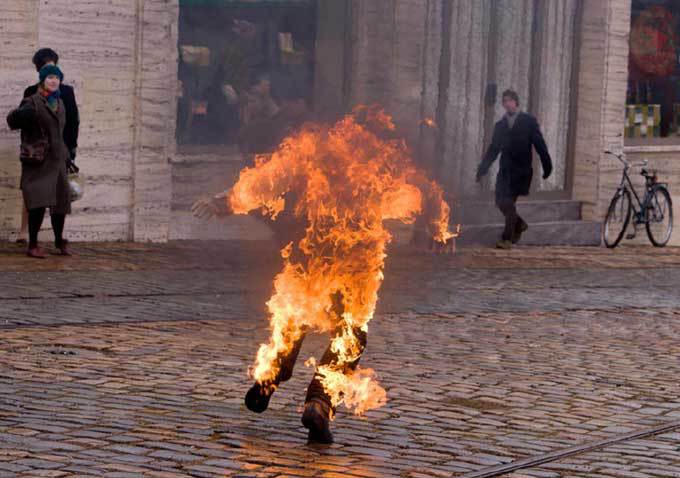
Agnieszka Holland's three-part HBO Europe miniseries is a picture of events in Czechoslovakia following a dramatic act of protest in 1969
Agnieszka Holland's superb three-part TV miniseries about the fight for liberty in a time of repression begins with the 21-year-old Czech student Jan Palach's act of protest. Out of nowhere on a damp, chilly day in January 1969 he sets fire to himself using a bucket of gasoline in Prague's Wenceslas Square (and subsequently dies) as a protest agains months of Soviet occupation of the country. Palach leaves a statement explaining he was one of a group who subsequently would continue these actions if nothing were done. Holland's beautifully staged and photographed episodes show in detail what came next, a web of people and events all fanning out from this simple shocking one.
The authorities immediately mount a frantic effort to tamp down any further protest and find out who the others in Palach's group are. Their belief ostensibly is that rebellion will bring on further Soviet repression: the purpose of Palach's action nonetheless does come out. A police officer is put in charge of an investigation, Major Jire. He is played by Ivan Trojan, who recently also played the good cop fighting a corrupt system in David Ondrícek's In the Shado (2012; SFJFF 2013), set in 1953, when the Soviets are using ex-Nazis to stage anti-Semitic show trials.
Later a Czech party hack and regional parliament member, Vilém Nový (Martin Huba), is manipulated by the Soviets to give a speech undermining Jan Palach's protest, saying he was really a fascist nut who meant to fake his self-immolation but had it backfire. When news of this is published Jan's mother Libuse (Jaroslava Pokorná) and brother Jiri (Petr Stach) call on beautiful young attorney Dagmar Buresova (Tatiana Pauhofova) to take on the party hack in a libel case, which becomes the focus of the action. This is cleverly intertwined with scenes involving members of Jan's dissident group. Major Jiri finds the student who was closest to being Jan's girlfriend, Hana Cízková (Emma Smetana), and when when she is devastated after Jan's death coerces her into reading a fabricated statement in which Jan supposedly asks his allies to refrain from further self-immolation.
It gets more complicated and inbred, but in ways that seem thoroughly logical while you're watching, and momentum comes from the energetic legal procedural story. Dagmar's legal office-mate Vladimir Charouz (Adrian Jastraban) has a daughter, Vladka (Jenovéfa Boková) who's one of the dissidents, and who's found out by secret police Major Docekal (Igor Bares). Nový's lawyer controls the judge in the libel case, who's told what the outcome must be (Ivana Uhlirova). Within this context the young dissidents still strive and so does Dagmar, the beautiful attorney, who does everything to win the libel case. The Margaret Rutherford-like Jaroslava Pokorná as Jan's mother becomes a surprisingly strong figure, an old peasant-y lady who continually grows more her son's stubborn and explosive advocate.
Nonetheless the forces of repression are relentless and Dagmar's doctor husband Radim (Jan Budar), as well as Libuse and Jiri, are battered and browbeaten by the authorities. Even Jan Palach's grave is dug up and his coffin cremated and the ashes disappeared on the grounds that vistis to his grave caused disorder. Dagmar Buresova loses the case, which takes up much of the second and third episodes, but twenty years later Jan Palach is celebrated by protesters just before the fall of the Soviet Union, and the charismatic Dagmar became the first Czech minister of jutice in the post-communist era, closing titles tell us.
First time script writer Stepan Hulik maintains momentum, interweaves multiple characters and story lines, keeps the focus constantly on both repression and idealism, and yet avoids any easy or obvious climaxes or simplistic demonizing. There are always interesting people on screen. Dagmar's office assistant and investigative ally Ondrej Trávnícek, really one of the dissenters too, is played by the very handsome Vojtech Kotek. It looks as if Dagmar and Ondrej will be the hot young couple of the piece for a while, even though Dagmar is married and has two children. One remembers Holland's vivid use of young actors in earlier works like Europa Europa; Olivier, Olivier, and Total Eclipse.
Whatever happens though, the unifying thread is the balance of fear and repression against the will to resist. Seamless costume and period design and great photography by Martin Strba and Rafal Paradowski combine with uniformly good acting to provide a very classy mini-series (Holland has worked on "The Wire" and "Trame").
Burning Bush/Horící ker, in Czech, 231 mins., was made for HBO Europe, debuted at Karlovy Vary and Roterdam, was also shown at Toronto, and was screened for this review as part of the New York Film Festival at Lincoln Center, Sept 2013. It is the Czech Republic's entry for the Best Foreign Oscar.
Last edited by Chris Knipp; 01-02-2015 at 06:55 PM.
-
Catherine Breillat: ABUSE OF WEAKNESS (2013)
CATHERINE BREILLAT: ABUSE OF WEAKNESS (2013)
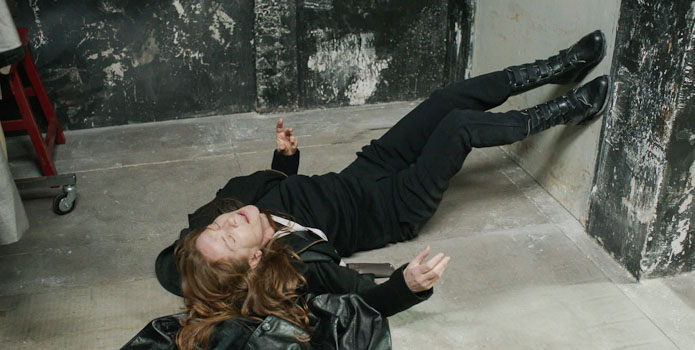
Isabelle Huppert in Abuse of Weakness
She was herself yet not herself, says the conned artist in Breillat's neat, elegant memoir
Again Breillat has made a neat, elegant, beautiful film, this time even more than usual intimately autobiographical. She really was disabled by a major cerebral hemorrhage and followup epileptic seizures, and when at home from the hospital sought out a self-declared jailbird and con man she saw on a TV show. She made him part of her life, became dependent on him, and he conned her out of about 800,000 euros -- maybe almost €1 million. It all happened eight years ago. The film is a picture both classic and unique of what it's like to be this kind of victim. And incidentally Huppert is remarkably adept at mimicking post-stroke disabilities. The story's uncomfortable to watch, necessarily so, and arguably also a bit narrow. But it rings true and is a good account of the experience of being conned, as well as a remarkable performance by Huppert.
Though Breillat likes to work with unknowns, that may not have been a real option for someone to play her alter ego here. If you were a famous French artist who's both stubborn and arbitrary seeking an actress to play yourself you'd need not look beyond the celebrated Isabelle Huppert, and Huppert delivers even more balls and panache than usual for this performance, which somehow seems both flamboyant and understated, the paradox a product of Breillat's succinct self-characterization.
First Maud (Huppert) falls out of bed, crawls to a phone, wakes up in hospital, and learns she's disabled, her left arm flopping up in the air, her legs weak and unstable (we don't see physical therapy). At home, her body "half dead," facing a new solitude. On nighttime TV Maud spots Vilko Piran (muscular, tattooed, middle-aged French rapper Kool Shen) and calls her working partner Ezzé (Christophe Sermet) to tune in. They agree his baldfaced crudeness is priceless for the part they're casting, and before long she has him over and he agrees to act in her next film. He promises to spend a lot of time with her. She never is with actors before shooting, she says, but in this new situation.... the bold, outrageous Vilko, who wears nice clothes and boasts "chugging" Chateau Petrus, is soon spending time with Maud nearly every day and becomes her "slave."
Then the "borrowing" begins, and Maud writes Vilko huge checks -- 50,000, 100,000, 200,000 euros -- right from the start. It seems to make sense at the time.
The part that rings true is that the victim gets value from the victimizer, albeit for excessive cost (Maud feels abandoned by family and needs Vilko's company and his physical help); that the victimizer needs and may deeply care for his victim, thus "kills the thing he loves"; that the victim knows she is being conned, yet goes along with it; that the relationship is an intimate and strangely "caring" one. In this case, especially with Huppert in the role, the victim largely seems stronger than the victimizer, and Vilko acknowledges Maud's "balls."
As Peter Debruge notes in his Variety review -- to which you may refer for background details such as what movie Breillat would have made, who the real con man was and what legal action she took -- Breillat's habit of casting "real" people, showing a misguided distrust of actors and leading to limited performances, further backfired in a major way in this experience. Such limitation marks the turn here by non-actor Kool Shen, whose behavior in scenes is rather one-note. In contrast Huppert's mastery makes her performance look so easy you may not at first notice how complex and contradictory her Maude is, powerful as well as frail, as sympathetic as she is chilly and off-putting.
But this is a hard movie to describe. The succinct fresh rawness of it is underlined for me by the way Maud simply clicks off her cell phone whenever she's done talking, without a goodbye.
Abuse of Weakness/Abus de faiblesse, 105 mins., debuted at Toronto 6 Sept., and will be shown a month later at the New York Film Festival at Lincoln Center, where it was screened for this review. It opens theatrically in France in Feb. 2014.
US theatrical release by Strand begins 15 August 2014. Watch for other dates and locations, or the US DVD./
Last edited by Chris Knipp; 01-02-2015 at 06:57 PM.
-
Joel, Ethan Coen: INSIDE LLEWYN DAVIS (2013)
JOEL, ETHAN COEN: INSIDE LLEWYN DAVIS (2013)
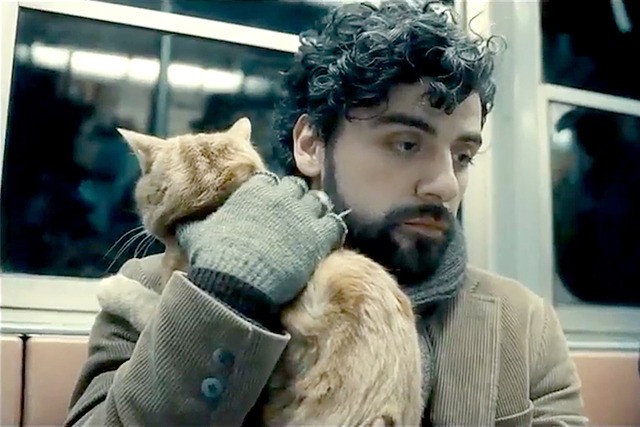
Pscar Osaac om Inside Llewyn David
The Coen brothers do the Sixties Greenwich Village music scene, with surreal touches
The Coens' Inside Llewyn Davis is a period musical film and hence invites comparison to the siblings' O Brother, Where Art Thou? Indeed again there's even a kind of "Odyssey" theme, only the milieu is of "folk" music of the early Sixties as it sprang up in New York's Greenwich Village, rather than country music and blue grass in the Thirties American South. Llewyn Davis was warmly received at Cannes and has a sky-high critical rating, but beware -- it's a head-scratcher and a bit of a downer, despite its mild manner. It lacks the penetrating ironies of A Serious Man or the violence of No Country for Old Men. Fortunately, perhaps though continually battered, frustrated, and broke, this hero doesn't come to a bad end. It may be assumed that despite vicissitudes Llewyn Davis will somehow fare forth, remaining a musician and singer if lacking material success. But at the same time, the "Odyssey" theme doesn't mean the film's "Ulysses," the eponymous hero (Oscar Isaac) ever gets anywhere. In fact the narrative is circular, the final scene showing Llewyn getting the same beating he gets outside the Village cafe as in the opening sequence, the assailant and the reason for his grudge being made clear the second time around. There are good songs, well performed, and the dark, gloomy winter images by Amélie DP Bruno Delbonnel, filling in for the Coens regular Roger Deakins, are handsome. But Inside Llewyn Davis does not emerge as the Coens at their most successful or meaningful.
In the action, Llewyn, loosely based on Dave von Ronk, couch-surfs round New York City, returning to the Village club and record producers he's seeking to use as a springboard to a success that never comes. In the film's most original passge, he rides to Chicago with a laconic Garrett Hedlund driving and a mysterous John Goodman riding in the back, playing for producer F. Murray Abraham who just says, "I don't see any money in this." Like Ulysses, he would return to sailing, trying to renew his merchant seaman card, but in that effort, like so much else, he fails. Though the theme may not be quite clear, Llewyn, like von Ronk, represents the "authentic," "period" folkies who, by implication, were swept away when folk-inspired singer-songwriters like Bob Dylan burst on the scene. This must be qualified, because there's never been anybody quite "like" Bob Dylan, and because there were other original folk-inspired songwriters before Dylan's first album.
As someone who was there, so to speak, I must also protest that people just didn't talk like this. Middle class young women like the one played by Carey Mulligan, married to a buttoned-down Justin Timbrerlake -- also a folksinging couple -- did not use the F-word in every sentence as she does, no matter how angry they were at another young man for getting them pregnant. Indeed all of the characters in this film rend the air in every scene using language that was not yet current among educated people. The profanity is used for a comic effect that relies on a falsification of the period. Hence the "inspired period detailing of production designer Jess Gonchor" Scott Foundas speaks of in his glowing Variety review of this film, indeed abounding as he says in "cramped cold-water flats" and "Kafka-esue hallways narrowing toward infinity" -- and thus evoking the pinched Lower Manhattan of artistic hopefuls of this era truly different from the posh Village of today -- is spoiled by the tone-deaf dialogue.
Another theme that may not emerge very clearly is that Llewyn is not a nice guy, but a great musician and singer, thus illustrating (no revelation, this) that genius and niceness are not necessarily linked. Jean (Mulligan's character) thinks he's an irresponsible cocksman, and indeed he has engaged the services of an abortionist before. But he never seems all that selfish or mean. He visits his senile dad and sings him a song. He weathers Jean's abuse patiently. He does have a tantrum at the MacDougal Street’s Gaslight Cafe (identified by Foundas as the venue). But given the frustrations he endures throughout the two weeks covered in the film, an explosion seems justified. So does his refusal to sing for his dead singing partner MIke's parents, or to allow MIke's mother to sing Mike's part. And yet these two outbursts are forgiven by their respective victims far too easily. I was never clear how one was supposed to take Llewyn, or the music. The Coens's habitual dryness of affect this time makes what may be meant as cool but affectionate realism feel instead like cruel and inexplicable satire.
Inside Llewyn Davis has its gloomy, patient Odyssey to nowhere. But it provides a narrative with no payoff, perhaps worse than no narrative at all. In the end its threads seems as pointless as the orange cat that escapes when Llewyn leaves Mike's parents' place early in the film, which he feels obliged to carry around with him. It's a unifying thread whose meaning we may struggle in vain to interpret. (Reports are that this film has a lot of improvisation.) The best part is the strange, surreal drive cross-country with Johnny Five (Hedlund) and Roland Turner (Goodman), when the film forgets its dubious need to evoke an era and a milieu and wanders into pure cinematic territory. I'd like to have continued on that journey.
Inside Llewyn Davis, 104 mins., debuted at Cannes, where it won the Grand Prix (the second highest competition feature award) and will be showcased at other festivals, including New York, where it was screened for this review. Limited US release 6 December 2013; UK release, 24 January 2014.
Last edited by Chris Knipp; 01-02-2025 at 11:31 PM.
-
Joe Brewster and Michèle Stephenson: AMERICAN PROMISE (2013)
JOE BREWSTER AND MICHÈLE STEPHENSON: AMERICAN PROMISE (2013)
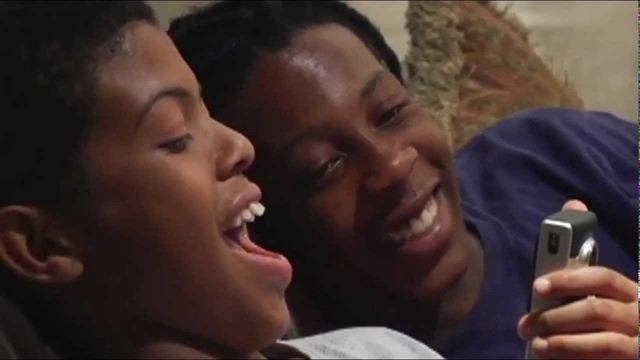
Idris and Seun in American Promise
Almost everything about two boys growing up, together, and then not: a document of 12 years
The parents of Idris (pronounced "EE-driss") are Joe Brewster and Michèle Stephenson, middle-class African-Americans living in Brooklyn who are also filmmakers. He is also a psychiatrist educated at Harvard and Standford; she is a lawyer educated at McGill and Columbia. At one point, seeking in vain for work "for hire" that they could truly commit to, inspired by Michael Apted's "Up" series, they decided to take up cameras themselves and shoot their own son and other children attending the prestigious Dalton School, in Manhattan, which had a commitment to maintaining a racially diverse student body. Eventually their subjects narrowed to their son and a friend. He was Olowaseun (Seun, pronounced "SHAY-un," subsequently shortened to "Shay"), son of Stacey and Anthony Sommers, a nursing care manager and CBS systems engineer, respectively, also African-American, middle class, and Brooklyn residents, who probably met at S.U.N.Y. Binghamton, which they both attended.
As little boys both are charming. Idris is candid, articulate, and sweet. Seun is warm, a charmer. Idris is precocious in basketball at Dalton in middle school. But he hits a snag when he isn't promoted to the varsity team. Though a great player and scorer, he is small.
This documentary follows Idris and Seun over a period of 12 years, from kindergarten to the start of college, age 5 to 18 -- though Seun was not promoted from Dalton Middle School to High School and instead transferred to Benjamin Banneker, in Brooklyn. It's a rich saga, an intimate picture of the two young men, their academic struggles, and their parents' efforts to make them do well. Idris and Seun are good friends till Seun leaves Dalton; then they don't see each other very often. The "Directors Statement" offers interesting information that's not in the film. It explains that Joe and Michèle became good friends of the Sommers, to the point that they sometimes had to put down the camera when around them so as not to jeopardize that friendship, trusting that the accumulation of material would make up for the moments lost. They also note the leap forward into HD digital cameras that made the technical side easier and the results better (some of the early footage looks crappy by comparison with later images). Funding also improved.
What is the "American Promise"? Equality, no doubt; the opportunity to achieve excellence whatever one's background. And the film above all shows how hard it can be for a young black male to do well even in very promising circumstances. This film, like Apted's films, lets its subjects do the talking, along with some others, notably their parents, also school administrators and teachers. There is a class at Dalton taught by a young black man discussing Ralph Ellison's Invisible Man. We see Seun being tested for a promotion in karate. We see Idriss playing basketball at Dalton. We see him visit Stanford. He does not get in, but he wants to study in California, and decides to go to Occidental, in L.A. To some extent this is a story of dreams deferred, but it's also a story of opportunity granted. Bu did Dalton really give Idris a head start, or was Seun more nurtured at the all-black school, Bannaker?
How many times do we see the parents tell Idris or Seun that they're lazy? Joe and Michèle decided to present themselves with a degree of ruthless honesty, and their, and also Seun's father's, attitude toward their sons sometimes seems unfair. Michèle comes off as a kind of stage mother, always seeming worried that Indris won't do as well as she would like. This reflects the mood of the America of this generation. The Dalton white kids' parents are worried too, and pay out a fortune for extra tutoring the black parents can't afford. But Dalton administrators say the black males have troubles the black girls don't. And specific problems are found. Both boys have academic troubles at Dalton. Seun is found to be dyslexic; later Indris is diagnosed as having "attention deficit disorder" (ADD), and Idris starts taking the common medication for this, ritalin. The film shows Idris performing differently and showing symptoms of taking a stimulant; but whether his school performance improves isn't really made clear.
Both boys seem bright. Idris particularly seems sophisticated and verbal as well as senstiive, perhaps socially less mature and secure in his own skin than "Shay." Idris's grades are average, apparently, making his goal of getting into Stanford unlikely. Why? Why don't they both do better, despite their parents working overtime to help them? Why is Idris's father, a psychiatrist, so often satisfied with the explanation that Idris is "lazy" and doesn't "push" hard enough?
All this remains something of a mystery. But ultimately we need to see this film in terms of Apted's "Up" series, an accumulation of almost an infinity of little personal day-to-day details over time about its subjects that reveal the tenor of their lives, with no need to give answers. And we can't help hoping Joe and Michèle will provide us with pictures of Idris and "Shay" in the future, at intervals, to see what becomes of them. A life is a wonderful thing to watch unfold.
American Promise, 135 mins., debuted at Sundance, January 2013, and was screened for this review as part of the New York Film Festival at Lincoln Center, September 2013. A theatrical release will begin in NYC at IFC Center and Lincoln Center Oct. 18, 2013. There will be a PBS Premiere: February 3, 2014 in the POV series. There will also be a book planned for winter 2014 release, Promises Kept: How to Help Black Boys Succeed in School and in Life- Lessons Learned from the 12-Year American Promise Project. See the American Promise website for other information.
Last edited by Chris Knipp; 01-02-2015 at 07:03 PM.
-
Paul Greengrass: CAPTAIN PHILLIPS (2003
PAUL GREENGRASS: CAPTAIN PHILLIPS (2013)
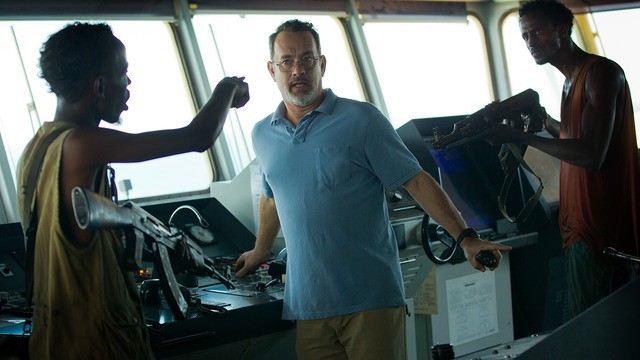
Barkha Abdi and Tom Hanks in Captain Philips
Greengrass and Hanks' Somali hijacking film favors action and emotion over specifics
[S P O I L E R S]
Paul Greengrass' Captain Phillips is a movie based on a 2009 incident of a container ship with a US captain by this name that Somali fishermen attempted to hijack, the MV Maersk Alabama , ironically then carrying 5,000 tons of African relief supplies. Compare the recent Danish film directed by Tobias Lindholm, A Hijacking (ND/NF 2013), based on several similar incidents, and combining focus on shipboard events involving Danish crew and Somalis, with tense ransom negotiations by the shipowners back at home. The Hollywood film eschews the corporate POV at home to which A Hijacking constantly returns but adds a famous star and, for action drama, a military operation (which actually occurred) to free the ship and subdue the young Somalis. Real negotiations never actually get going between pirates and shipowners of the huge Maersk container ship captained by Captain Richard Phillips (Tom Hanks). Why would they -- when a battleship and the Navy SEALS can be called in to sweep away the Somalis? This reportedly was the first seizure by pirates of a ship flying the American flag since the early 1800's -- but since It was the sixth vessel in a week to be attacked by pirates who'd gotten ransoms in the tens of millions of dollars, maybe the US overkill was a wise corrective move.
But seeing Greengrass' film after Lindholm's may leave you feeling cheated of the edgy drama of bargaining when big property values and human lives are at stake -- which winds up being the suspenseful process depicted in Lindholm's film, and has been happening a lot, in waters where Somalis lurk.
Maybe the Somalis this time aren't experienced enough, but the Americans resort to trickery from the start, while in A Hijacking the Danes are just out to make the toughest deal they can. Greengrass, who made the strong docudramas Bloody Sunday and United 93 and the highly entertaining second and third Bourne episodes, is definitely a world class action movie director. But in its emphasis on action Captain Phillips loses a lot of characterization detail and narrative specifics. What you do have is Tom Hanks, and despite a mundane beginning, he delivers some profoundly open emotion at the end in enacting the captain's state of nerves and devastation when his ordeal is over.
Each of these two films is well done in its way. The higher profile Tom Hanks film will get as good reviews as A Hijacking and perhaps Oscar attention but it's not yet clear how big it will be at the box office. Mainstream viewers may be put off not only by the lack of definition or subtlety among the Somalis but also a pretty muddled middle section and finale and a lot of subtitles, as well as the lack of any name actor besides Hanks.
Whereas viewers of A Hijacking will remember the slow, suspenseful negotiations, the company head and his hired advisor versus the pirates and the dire threats, tough dealing, and brutal consequences on the Somali pirates' side. In the Danish film, the Somalis are pros at their game. In the American one, the Somalis are inexperienced young hotheads who constantly fight among themselves. In Captain Phillips the American piracy experts and naval support's plans aren't fully revealed to us. Nor do we even know quite what they actually do other than lie to the Somalis and kill most of them. The contrast seems to fit differences between a small country's need to use limited means to best advantage versus American exceptionalism. The Danes make a deal; the US uses brute force.
Hanks has suggested he found an interpretive key to the real Captain Phillips, of Vermont (whose New England accent he sporadically evokes), when informed by Phillips' wife that he turns into a different, no-nonsense, ultra-serious man when he's in command of a ship. Actually, though, in the very hasty initial at-home segment, Hanks' captain and his wife (a barely glimpsed Catherine Keener) both seem pretty solemn, talking of little but how dangerous his work is and how much they both wish each time for it to be over.
Once the Somalis approach the ship, Phillips' strategy is to hide most of his crew in the engine room. He stalls the Somali's de facto leader Muse (Barkhad Abdi), getting broken glass thrown down at the engine room entrance so the barefoot youngest Somali, Bilal (Barkhad Abdirahman) gets a badly cut foot. The other personality that emerges among the hijackes is the wild-eyed Elmi (Mahat M. Ali), a tall hothead who constantly pushes for more violent and extreme action.
In the event, with these problems and the captain's trickery and delays, Muse doesn't have much of a chance to negotiate a ransom, though that, as in the Danish film, is what the Somalis were aiming for. None of the Somalis on the Alabama comes close to the cool, arrogant, experienced Omar (Abdihakin Asgar), who does the hijackers' negotiating in Lindholm's film. In Captain Phillips, the situation is dangerous but one-sided. To mix metaphors, Greengrass' Somalis are loose canons but not tough cookies.
To fit Greengrass' area of excellence, everything in Captain Phillips is boldly physical and visual. There's a noisy, exciting scene on shore at the outset showing the Somalis' chaotic selection process for the random hijacking mission, and many shots of the Maersk ship and the two skiffs, reduced to one when Phillips, in his first bit of trickery, scares the others off by broadcasting faked arrangements with a police vessel. The unique event in the Captain Phillips situation is Muse's decision to take the captain off the ship in a sealed lifeboat. And then as in a Bourne movie we switch back and forth between control centers, including the special fighter ship that supervises a Navy SEALS operation that is never quite made clear.
Shut in the closed, claustrophobic lifeboat with the crazed Somalis, Phillips must endure a hair-raising and ear-shattering attack from the US Navy and weapons fired off by the hijackers, including a small rocket right next to him -- noise almost as bad as this movie's thumping, bone-shaking score by Henry Jackman. The most memorable moment in the film is when Phillips is taken on board the rescue ship to a silent sick bay where a nurse tries to calm him. Hanks does a unique impression of a man shaken, terrified, and speechless after a violent ordeal.
As Todd McCarthy notes in Hollywood Reporter, this is another one of an elite group of fall-release "survival stories," including Gravity, 12 Years a Slave, and All Is Lost, the latter two also included in the NYFF. Each has its very different and valid directorial style and feel. But I'd ultimately agree with blogger Joe Bendel of j.b.spins" who found Greengrass' hijacking film inferior to Lindholm's in almost every respect, its second half clearly weaker than its first. This isn't up to Greengrass' best work.
Captain Phillips, 133 mins., a Sony Pictures Studios release, had its world premiere at the gala opening night of the New York Film Festival 27 Sept. 2013, when it was screened for this review; will also be in the London Film Festival. Screenplay by Billy Ray, based on the book by Richard Phillips with Stephan Talty. US release 11 Oct., UK, 18 Oct.
Last edited by Chris Knipp; 01-02-2015 at 07:06 PM.
-
Declan Lowney: ALAN PARTRIDGE (2013)
DECLAN LOWNEY: ALAN PARTRIDGE (2013)
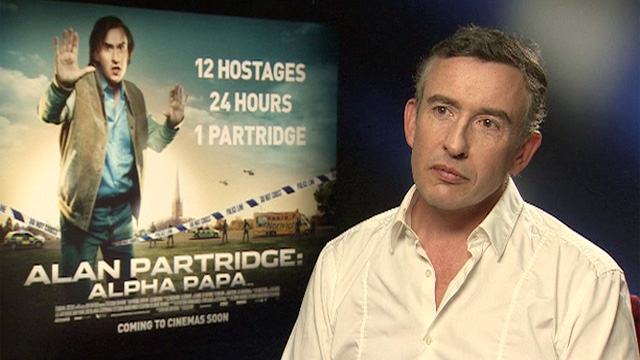
Steve Coogan
Steve Coogan triumphs as his goofily egocentric alter ego
This movie is a one-time big-screen outlet for Steve Coogan’s comic creation, originally (1997) radio, later TV. Alan Partridge is a Norwich-based radio emcee. The vain and obliviously tactless character in this iteration is called upon to serve as an intermediary when the radio station North Norfolk Digital" bought out by a multinational conglomerate and is about to be re-branded as "Shape." The station is subsequently subjected to a siege by Partridge's Irish colleague, Pat Farrrell (Colm Meaney) when he's let go in the process. "I'm Alan Partridge" was originally a BBC situation comedy starring Coogan with two series of six episodes each were produced — the first in 1997 and the second in 2000 (though Alan Partridge seems to go back to 1995).
This film, which got its North American debut at the prestigious and selective New York Film Festival is nonetheless very broad comedy material, and very English as well, as Coogan was first to point out at the New York festival Q&A. Coogan is an inspired comic, and he's most known in the US from performances in several films directed by Michael Winterbottom. Winterbottom's Tristram Shandy: A Cock and Bull Story, featuring Coogan, was part of the 2005 NYFF. Before that, Coogan had a lead role in perhaps Winterbottom's most celebrated feature, 24 Hour Party People (2002) Coogan was also very funny more recently in Winterbottom's The Trip, again a big-screen version of comedy from the Tube. Somewhat to his chagrin, Coogan often has minor roles in feature films, but he's nearly always very droll in them. I recently enjoyed him a lot, perhaps from knowing there's more there than shows on the surface, as the irresponsible art dealer husband Beale in an American film, Scott McGehee and David Siegel's contemporary version of Henry James's What Maisie Knew.
This feature film version of Alan Partridge relies on extreme situations and sometimes crude, scatological, or slapstick humor. It's more a series of jokes than anything else. It seeks, more or less successfully, to strike a balance between the triviality of a radio or TV sit-com and a serious film. It doesn't stray very far from its basic venue, the radio studios (which eventually become surrounded by onlookers, TV cameramen, journalists, and police). It stays parochial. Coogan explained that a comedy involving a siege by Al Qaeda was included, but that would have strayed onto dangerous ground. In the film Partridge warns a colleague not to joke about Islam. Christianity a lot, sure; Judaism a little. Islam, never.
Despite its broadness, Alan Partridge is anything but just sight gags. It's most of all a lot of profane, outrageous, rapid-fire verbal humor -- an intricate kind the Brits have a special knack for. It's therefore not a surprise to see the name of Armando Iannucci among the writers (who include Peter Baynham, Neil Gibbons and Rob Gibbons) and to remember that Coogan was included in In the Loop (2009), and Ianucci was deeply involved in the very fast, very witty, very political The Thick of It (2005).
This movie is sort of political, though not on the level of those two TV series/films: it's about a corporate takeover. That's economics, anyway. But the event is largely a pretext to display Partridge's ego. When he learns a downsizing is coming under the new owners of the radio station, he fingers Pat Farrell, and Farrell indeed gets cut. The irony (or one of them) is that Partridge should be sent in to placate the shotgun-wielding Farrell, when the latter is pretty likely to catch on at some point that this mediator is the root cause of his humiliation. Meanwhile Partridge, whose ego is forever way bigger than his talent, sees how his new role in the news as a local savior has greatly increased his fame, and concludes it's well worth his while to prolong the siege of the station as long as possible so he can stay in the limelight.
The many secondary characters are all sterling in this film, as has always been typical of British comedy and cinema. However the problem remains that however hilarious the lines and risible the action this is an enlargement of small screen material to a space where it looks a bit pushed. Certainly this is by no means an unworthy version of Coogan's most famous comic character, but it remains true that the character is better and larger than anything on screen. (The Irish-born director Declan Lowery has primarily worked in TV.)
Whether this is a movie worthy to be included in the elite and selective New York Film Festival is a question to be left up to the historians. Certainly the NYFf has included less important and less worthy stuff, and Coogan is an alumnus. The choice also fits in with the new Program Director Kent Jones's (or this year's Jury's) revealed penchant for English comedy, resulting in inclusion of Roger Mitchell's Le Week-End, a sardonic senior citizen relationship comedy, and Richard Curtis's sci-fi fantasy rom-com, About Time. Each fills a different space in the British comedy spectrum.
Alan Partridge (original UK title Alan Partridge: Alpha Papa), 90 mins., debuted in the UK in July and August; its North American premiere is in the New York Film Festival at Lincoln Center, where it was screened for this review.
Last edited by Chris Knipp; 01-02-2015 at 07:08 PM.
-
Kiyoshi Kurosawa: REAL (2013)
KIYOSHI KUROSAWA: REAL (2013)

Haruka Ayase and Takeru Satoh in Real
A muddled romance from the other Kurosawa
Real is Kiyoshi Kurosawa's first feature film since Tokyo Sonata( (2008). And it's beginning to seem like a very long time since the director's distinctive yet wholly Japanese horror films, The Cure (1997) and Pulse (2001). Kurosawa's 2012 TV mini-series Penance (SFIFF '13) was finely crafted and highly watchable but somehow the original distinctiveness and promise were lacking; and for that matter despite its garnering perhaps justified praise in the West, Tokyo Sonata (NYFF '08) wasn't an altogether original idea. This one isn't either, and it presents more wan material. Real delves into a Matrix-like connecting up of separate consciousnesses, only this time the consciousnesses are just two. They belong to young lovers who live in a nice apartment in Tokyo. One is in a coma, while the other tries to help by participating in a fancy neurological treatment method known as "sensing." So we get a romance, with fantasy and science fiction.
What could be more Japanese than the circumstances: a manga artist obsessed with work and unable to cope with the world outside the drawings, suicidal and obsessed with childhood? Kurosawa achieves a delicate look, using delicate-looking actors. The result is a film that's nicely crafted, with some good monster special effects, moirée links, and manga fantasy-corpses; but it's repetitious and overlong, taking forever to arrive at a long-obvious finale, flipping back and forth too often along the way. To Matrix and Inception are added Freudianism and a touch of Jurassic Park which really is more a reference to Japanese Fifties monster movies, which Kurosawa gets to do over with state-of-the-art CGI, but limp results. And to top it off this premise was already more intensely dealt with very recently in Lithuanian Kristina Buozyte's Vanishing Waves.
A young couple, Koichi (Takeru Satô) and Atsumi (Haruka Ayase) were childhood friends, now young adult lovers, who pledge to be together forever. One, now, is in a hospital in a coma after a failed suicide attempt. The other submits to the "sensing" process whereby the two's brains are connected, in hopes of finding why the act was done and restoring normal consciousness. "Real" is a giveaway title that warns you: you're not supposed to know what is and isn't. Who is the manga artist, and who is the neurologist? Who's in the coma, and who's delving into the unconscious lover's mind? Is any of this happening? "You can be in my dream if I can be in yours" Bob Dylan said. But who's dreaming?
Whatever the answers to these questions, you are in for a lot of visits to the couple's apartment and a lot of trips to an island where they both lived for a few years as kids. You're going to get a lot of glimpses of a little boy drenched with water. You're going to go hunting repeatedly for a childish sketch of a Plesiosaur that was unusually well executed. This for some reason might get the manga artist's confidence back. As Koichi, Takero Satoh is a pretty male ephebe type always dressed in loose cut-off paints, who draws more attention and gets more screen time than Haruka Ayase as Atsuko, the girl, and has elaborate hair that is dramatically askew in key scenes. After a while his hair began to seem more interesting than most of the rest of the movie.
It seems "sensing" leaves you with "side effects," like LSD. You may see things when returned to normal consciousness. And so the line between "real" and "unreal" begins to become blurred. The trouble is that Kurosawa has eventually blurred too many of his lines, to the point of not caring. And he has substituted a fairyland supernaturalism for the truly terrifying spookiness of his horror films, and chooses to end with a soppy romanticism. In short he has chosen treacle as the alternative to scaring the hell out of us. This is definitely a misstep by Kiyoshi Kurosawa, who seems to have lost his sense of feature film timing and structure after working on the lengthy, multi-section Penance.
Real/Riaru: Kanzen naru kubinagaryû no hi, 127 mins., opened in Japen June 2013, and was shown at Locarno and Toronto. Mike D'Angelo relayed the reaction of some when he tweeted: "I can't top this. RT @Astrostic: Real: INEPTION." (For further unfavorable fest reactions see Kayframe.) There really is a clumsiness about Kurosawa's over-and-overing of Coma stories, Inception, and Matrix. Screened as part of the New York Film Festival at Lincoln Center for this review, to which it was a last minute addition, perhaps out of loyalty to the director as a NYFF alumnus.
Last edited by Chris Knipp; 01-02-2015 at 07:10 PM.
-
agnès b.: MY NAME IS HMMM... (2013)
AGNÈS B.: MY NAME IS HMMM...(2013)

Lou-Leila Demiac in My Name is Hmmm. . .
Collage of abuse and escape marks debut for designer agnè b. [Agnès Troublé]
"That trip was the happiest memory of my childhood," says a woman we see only from behind, who speaks of satisfaction with a child of her own and trustworthy husband. "I often thought of Peter." So ends the fashion designer agnès b.'s feature film debut, the a story of an 11-year-old French girl (in Orléans), the oldest of three kids, who is sexually abused by her out-of-work dad and runs off from domestic trauma by leaving a school beach picnic with a strangely obliging Scottish trucker (that's Peter) for a drive southwest across France. Child sexual abuse is a disturbing theme that impresses us even as we find the cinematic means of enlivening the road trip clumsy and distracting. The irrelevant experimental clutter includes multiple screen formats with garish 16mm. color, an overlaid drawing, double images, a scene in black and white, previews flashed on a a TV monitor, two ashen butoh dancers in a wood, music from a Vivaldi contata, and other devices that all add artistic pretension without a necessary contribution to the action and wind up feeling amateurish and overreaching.
The film is also uncertainly paced and overlong. Even the opening at-home section establishing little Céline Meunier's oppressive situation drags, when it should shock and enthrall. The long section of the girl's flight with the trucker is shapeless and emotionally flat due to uninteresting writing and shaky actors.
Still the tragic aura of incestuous child sexual molestation hangs over the narrative. The power this lends the film also gets at least an initial boost from a notable cast the well-connected agnès b. has assembled. In the role of Céline-AKA-Hmmm's miserable father -- a weepy, perpetually nervous chap we're asked as much to pity as despise -- the film cast Jacques Bonnaffé (Lemming, The Page Turner), who positively exudes portentous gloom. As the girl's grandmother, too religious and innocent to guess what could be upsetting her, there is the French film and theatrical great Marie-Christine Barrault. As the girl's mother, we get the art-house idol Sylvie Testud (Fear and Trembling, La Vie en Rose, Lourdes). Claire Denis muse Grégoire Colin even has a cameo. More screen time however goes to the stiff Lou-Lélia Demerliac as the emotionally repressed girl (who does resemble Testud) and to non-actor, documentary filmmaker Douglas Gordon as the truck driver, a central character whose behavior never makes much sense.
It's initially established that mom (Testud) is out working at a local bar all the time, struggling to pay the bills with dad (Bonnaffé) moping around the house, tippling, and taking Céline upstairs in the evening to abuse her sexually before mom gets home. His brief soliloquys make it clear he hates himself, but can't stop. To externalize Céline's isolation and give her a voice the film resorts to the rather artificial device of having her constantly talk to a ratty little Barbie doll, in effect her main companion. Her classmates think her odd. She begs grandma to take her in, but grandma doesn't see cause to remove her from home. The school trip provides her escape. It's not clear exactly how she gets Peter to give her a ride in his truck. He shows her a little photo of wife and kids and utters a single word: "Dead." That is our explanation and motivation for what follows. Peter and Céline develop a playful, fun relationship that's obviously doomed, since radio reports of the girl's disappearance are followed up by posters of her face everywhere. She gives away that she's hiding by refusing to give her name. "Je m'appelle Hmmm. . ." (My name is Mmm) is all she'll tell anybody.
Eventually authorities close in, and Céline and Peter are taken away separately. What he does is surprising, inexplicable, and arguably irrelevant, a distraction from the theme that also shows an inability to work out a coherent narrative thread on the part of Agnès and co-script writer Jean-Pol Fargeau (who has often collaborated with Claire Denis).
My Name Is Hmmm. . . undoubtedly makes an impression but one may seriously question whether the filmmaking is accomplished enough to justify high profile film festival presence. Simpler means, better writing, and sharper pacing might have made of this an effective film.
My Name Is Hmmm. . . , 127 mins., debuted at Venice Aug. 2013 and was screened for this review as part of the New York Film Festival at Lincoln Center, September 2013. "agnès b." is the name of the clothing line owned by Agnès Troublé. Having a net worth in excess of 65 million euros and being a major patron of the arts, she has previously been involved in various film projects, including the restoration of Jacque Tati's Playtime. Theatrical release of Je m'appelle Hmmm... Apr. 2014 (AlloCiné press rating 2.1 (42%) from a limited response of 11 reviews; US release NYC Jan. 2015; Metascore: 32%.
Last edited by Chris Knipp; 08-23-2020 at 11:03 AM.
-
Hany Abu-Assad: OMAR (2013)
HANY ABU-ASSAD: OMAR (2013)
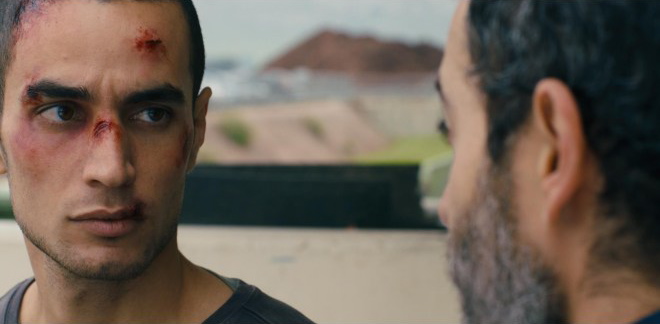
Adam Bakri and Waleed F. Zawaiter in Omar
Obligatory betrayals
Omar is Hany Abu-Assad's first film set in Palestinian territory since Paradise Now eight years ago (NYFF 2005). It's a clean, sharp, chiseled movie, like the look of his handsome and charismatic lead, Adam Bakri, who plays Omar. The issues are not so sharp or clear. In Paradise Now, which also had a stark, definitive look, the two young would be suicide bombing martyrs were muddled about their commitment. This plot is even more tangled. Maybe Omar makes sense if you're a Palestinian living in the territories. To outsiders it may look like game-playing or confusion. I would look further. Everything is relevant to the world depicted. But despite good acting, accomplished, lean filmmaking, and strong material, Omar feels in some ways contrived. And its boundaries are blurred, as shown by the fact that the Separation Wall Omar keeps scaling to see his girlfriend divides not Arabs from Jews, but Palestinians from Palestinians.
There are four young characters (all first-timers). Omar, the brave one, is in love with Nadia (Leem Lubany), the schoolgirl sister of his activist friend Tarek (Eyad Hourani), the adventurer. Together with the small, young jokester Amjad (Samer Bisharat), the pals plan to shoot an Israeli soldier. One of them makes the plan, another steals the car, and the third has to shoot the soldier. When it's done, Omar is captured, beaten, tortured, and released into the prison population, where he tells an undercover informant, "I'll never confess," which to the Israelis is confession enough. But they want the shooter. So the informant, Agent Rami (Waleed F. Zuaiter) offers to get Omar released. If he can point them to Tarek, who they think held the gun, Omar can avoid jail time.
Omar goes back out, but instead of turning in Tarek gets involved in another action he plans to ambush soldiers in a cafe. This goes awry, though, showing that someone is betraying them. Omar is connected with his friends, Nadia, her family. Who is it? Strangely enough, Agent Rami sticks his neck out, so he says, to get Omar released one more time, with a second chance to turn in Tarek.
Now because Omar has been in jail, the community begins to suspect him. Eventually that includes Nadia. Indeed Omar has made a promise to Agent Rami. Is the latter Israeli or Arab? One scene makes that confusing, but may be meant to show how good Israelis are at posing as Palestinians. Finally, it comes out who the opportunist has been. Omar winds up at a dead end, left with nothing but a choice between complicity or a desperate act.
Acting is good, from experienced pro Waleed F. Zuaiter (also producer) on down, particularly the sensitive-faced lead, who as Abu-Assad says, "jumps off the screen." The way Abu-Assad complicates the web of complicity and suspicion by adding love makes Omar seem almost Shakespearean, but hence also more theatrical -- and not at all time-bomb-tense like Paradise Now.. With Omar, this filmmaker has now had the distinction of having two Palestinian films submitted for the Best Foreign Oscar, and Paradise Now was the only Palestinian film actually made a finalist for the award. These are a far cry from the subtle ironies of Elia Suleiman, whose Divine Intervention was the first such submission (2003) I personally wonder if "freedom fighter" AKA "terrorist" acts might be the wrong material for Palestinians to submit, and if the joint Israeli-Palestinian film Ajami (Israeli's 2009 Best Foreign Oscar nominee) isn't a more rounded and human cinematic depiction of the brutal, chaotic world Palestinians live in.
Omar, 93 mins., debuted at Cannes (Un Certain Regard; Jury Prize), and was screened for this review as part of the New York Film Festival at Lincoln Center. The film opened in New York and Los Angeles Fri. 21 Feb. 2014 and A.O. Scott reviewed it in the NY Times, admitting he risked insensitivity in doing so but unable to resist saying that the conflict has been "a boon to ambitious genre filmmaking." Scott noted in this connection that Omar, "tightly plotted and cleanly shot (and an Oscar nominee for best foreign-language film), has the speed and suspense of a crime thriller." He described Omar, the protagonist played by Adam Bakri, as "the sensitive one, handsome and athletic with the soul of a poet."
Last edited by Chris Knipp; 01-02-2015 at 07:17 PM.
-
James Gray: THE IMMIGRANT (2013)
JAMES GRAY: THE IMMIGRANT (2013)
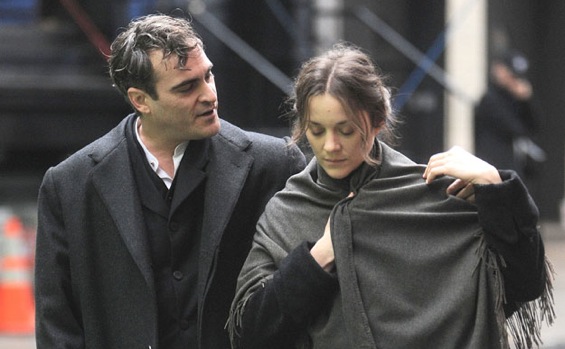
Joaquin Phoenix and Marion Cotillard in The Immigrant
Long slow vicissitudes
James Gray, grandson of Russian Jewish immigrants to New York, has made a film about a Polish Catholic woman in the early Prohibition era who runs afoul of an exploiter who saves her from being deported at Ellis Island in exchange for becoming a prostitute. It's like indentured servitude. Her sister was put in the hospital with TB and -- well, it's a long, sad story. And it's told for us through Marion Cotillard as Ewa, the Polish woman, Joaquin Phoenix as Bruno Weiss, the "impresario," and Jeremy Renner as Bruno's magician cousin, Emil, AKA Orlando. They deliver, especially the ever-soulful Cotillard, who even acts some of her scenes convincingly in Polish. But a story like this should be epic, and intense, and rich in adventures, and Gray's screenplay, cowritten with Ric Menello (who collaborated on his fine Two Lovers) never quite finds tone or momentum. What we get are authentic details, sepia tints, handsome photography and delicate lighting. It's enough to set a mood, almost even cast a spell. But we get nowhere to go with it.
That's the point, of course: Gray takes his time to lovingly create a mood in which a woman is trapped, but has the fortitude and moral strength to survive squalid circumstances. Ewa's behavior on board the ship reportedly was improper (the men were brutal on the unprotected women), and her sister's being quarantined means she must struggle to stay in the country and somehow by nearby to help. Bruno comes along when needed, with undefined connections with Immigration authorities, and gets her released into his care. Both actors are interesting together, Phoenix a mixture of kindly and exploitative, Cotillard a roiling blend of resentment and gratitude. What Gray's aiming at is a portrait of forgiveness. He's said that's why he chose to focus on a Catholic woman rather than the Jews of his own family. He's interested in compromises and moral complexity and the willingness to acknowledge indebtedness even when the benefactor had questionable motives.
This, of course, isn't an action movie. A return to Ellis Island to see Ewa's sister, with a magic show (meaningfully involving levitation) involving the cousin (Renner) and singing performance by Caruso, and a couple of abortive trips by Ewa to her aunt in Brooklyn; even dramatic fights between Emil and Bruno, who begin to compete for Ewa's attentions, still don't keep the placid trajectory from seeming a bit tame and static. In a way Gray is still thinking in the dualistic terms of Two Lovers. And maybe he ought to have stayed more that way, instead of introducing the competition for Ewa between Phoenix and Renner. The latter hasn't the heft of Phoenix as a personality, and though his fly-by-night character, a trickster and gambler who yet claims to be more of a decent fellow, is a new departure for Renner and interesting casting, the subplot just seems like a distraction.
People are saying this affirms Gray's classicism as a filmmaker inspired by golden decades of Hollywood (the Fifties? Seventies?), but his old-fashioned-ness had more sex appeal when he dealt with gangsters. Cotillard can never do wrong and Joaquin Phoenix remains an actor with an odd unexpected edge, but this seems like simply an impressive-looking wrong turn.
The Immigrant, 120 mins., debuted at Cannes May 2013, with subsequent showings at a number of international film festivals, including New York, at Lincoln Center where it was screened for this review. Theatrical release scheduled for various countries, including France 27 Nov, 2013. Limited US release began 16 May 2014.
Last edited by Chris Knipp; 01-02-2015 at 07:20 PM.
 Posting Permissions
Posting Permissions
- You may not post new threads
- You may not post replies
- You may not post attachments
- You may not edit your posts
-
Forum Rules





 Reply With Quote
Reply With Quote















Bookmarks